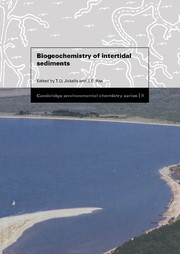Book contents
- Frontmatter
- Contents
- List of contributors
- Preface
- 1 Biogeochemistry of intertidal sediments
- 2 Trace metals in deposited intertidal sediments
- 3 Modelling adsorption and desorption processes in estuaries
- 4 A critical appraisal of the methodology used in studies of material flux between saltmarshes and coastal waters
- 5 Nutrient recycling in intertidal sediments
- 6 An overview of carbon and sulphur cycling in marine sediments
- 7 Microbial activity and diagenesis in saltmarsh sediments, North Norfolk, England
- 8 The behaviour of radionuclides in the coastal and estuarine environments of the Irish Sea
- 9 The sorption of hydrophobic pyrethroid insecticides to estuarine particles: a compilation of recent research
- Index
3 - Modelling adsorption and desorption processes in estuaries
Published online by Cambridge University Press: 23 September 2009
- Frontmatter
- Contents
- List of contributors
- Preface
- 1 Biogeochemistry of intertidal sediments
- 2 Trace metals in deposited intertidal sediments
- 3 Modelling adsorption and desorption processes in estuaries
- 4 A critical appraisal of the methodology used in studies of material flux between saltmarshes and coastal waters
- 5 Nutrient recycling in intertidal sediments
- 6 An overview of carbon and sulphur cycling in marine sediments
- 7 Microbial activity and diagenesis in saltmarsh sediments, North Norfolk, England
- 8 The behaviour of radionuclides in the coastal and estuarine environments of the Irish Sea
- 9 The sorption of hydrophobic pyrethroid insecticides to estuarine particles: a compilation of recent research
- Index
Summary
Introduction
Many inorganic and organic pollutants are of great concern to water quality managers owing to their persistence, toxicity and liability to bioaccumulate (Tanabe, 1988; Robards & Worsfold, 1991; Bryan & Langston, 1992; McCain et al, 1992; Förstner, 1993). The major temporary or ultimate sink for such pollutants in estuaries is the sedimentary reservoir, including intertidal deposits (Hanson, Evans & Colby, 1993; van Zoest & van Eck, 1993; Kennicutt et al., 1994), and definition of the biogeochemical mechanisms by which they absorb onto, desorb from and repartition amongst natural, heterogeneous particle populations is essential in order to assess their environmental fate. In estuaries, prediction of the distribution of pollutants is further compounded by intense temporal and spatial gradients of the reaction controlling variables such as salinity, dissolved oxygen concentration and particle composition, occurring both within the sediment and in the water column during particle suspension.
This chapter focuses on an empirical technique to study the sorptive behaviour of trace metals and trace organic compounds in estuaries. Thus, the partitioning of constituents between particles and solution is determined experimentally, without identifying the inherent reaction mechanisms or reactant speciation, under controlled laboratory conditions using natural samples spiked with radiotracer analogues of the constituent of interest (Turner et al., 1993). Adsorption and desorption processes may be modelled as a function of particle concentration, and the controlled variables of salinity and dissolved oxygen concentration, by incorporating empirically derived results into simple mass balance equations.
- Type
- Chapter
- Information
- Biogeochemistry of Intertidal Sediments , pp. 42 - 58Publisher: Cambridge University PressPrint publication year: 1997
- 3
- Cited by



